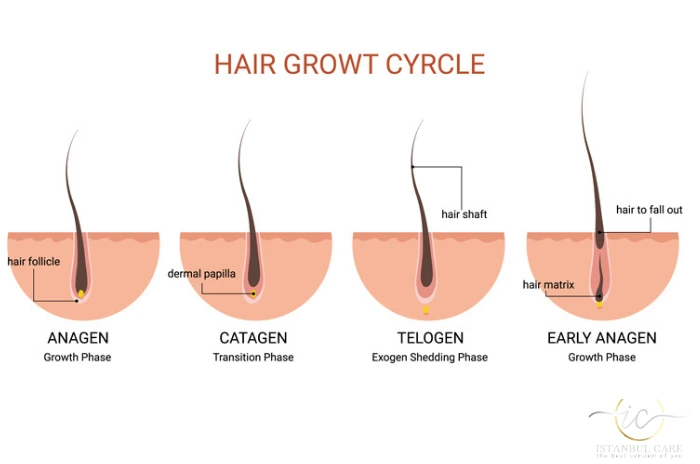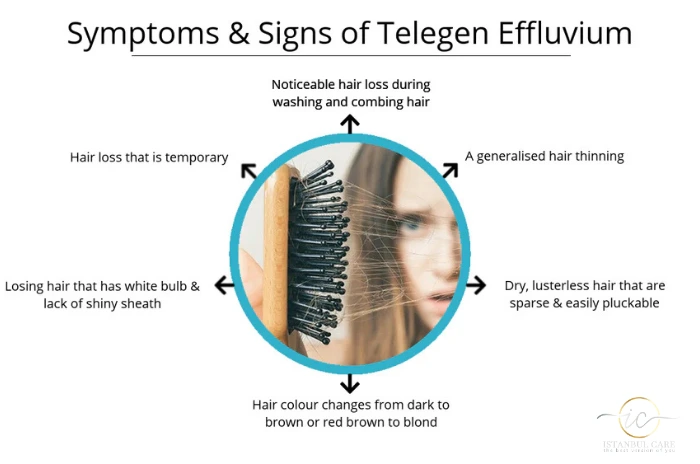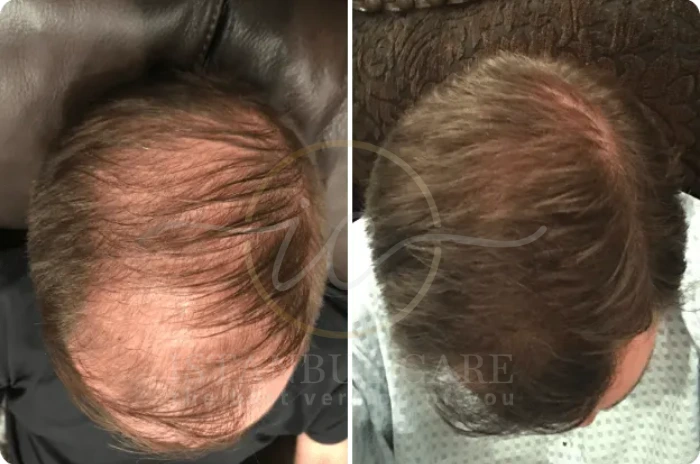Telogen effluvium represents one of the most common forms of temporary hair loss affecting millions worldwide. This condition causes significant hair shedding and diffuse hair thinning, often leaving individuals concerned about their appearance. Understanding telogen effluvium symptoms, causes, and telogen effluvium treatment options is crucial for anyone experiencing this distressing condition.
Unlike permanent forms of hair loss, telogen effluvium typically occurs as a response to physical or emotional stress, illness, hormonal changes, or nutritional deficiencies. The condition disrupts the normal hair growth cycle, pushing more hair follicles into the resting phase prematurely. This results in increased hair shedding that becomes noticeable 2-3 months after the triggering event. While alarming, most cases are reversible with proper identification and management.

What Is Telogen Effluvium (Rapid Hair Loss)?
Telogen effluvium is a form of non-scarring alopecia characterized by diffuse hair thinning across the entire scalp rather than specific areas. This condition occurs when a significant number of hair follicles enter the telogen (resting) phase of the hair growth cycle simultaneously. During normal circumstances, only 10-15% of hair follicles are in the telogen phase at any given time. However, in telogen effluvium, this percentage can increase dramatically to 30% or more.
The condition manifests as excessive hair shedding that typically becomes apparent 2-3 months after the triggering event. Unlike androgenic alopecia, which causes pattern baldness, telogen effluvium affects the entire scalp uniformly. The hair loss is usually temporary hair loss, with most individuals experiencing complete hair regrowth once the underlying cause is addressed.
Understanding the Hair Growth Cycle
The hair growth cycle consists of three distinct phases: anagen (growth), catagen (transition), and telogen (resting). The anagen phase lasts 2-7 years and represents the active growth period when hair follicles produce new hair. The catagen phase is a brief 2-3 week transitional period where growth stops. Finally, the telogen phase lasts approximately 3 months, during which the hair remains dormant before naturally shedding.
In healthy individuals, approximately 85-90% of hair follicles are in the anagen phase, 1% in catagen, and 10-15% in telogen at any time. Telogen effluvium disrupts this balance by forcing a larger percentage of follicles into the telogen phase prematurely.
Temporary Hair Thinning Explained
Temporary hair loss associated with telogen effluvium differs significantly from permanent forms of alopecia. The hair follicles remain intact and healthy, retaining their ability to produce new hair once the triggering factor is removed. This distinguishes telogen effluvium from conditions like androgenic alopecia, where follicles gradually miniaturize.
The thinning hair becomes noticeable as the increased number of follicles in telogen begin shedding simultaneously. Since hair takes approximately 3 months to grow from the follicle to the scalp surface, the hair shedding becomes apparent 2-3 months after the initial trigger.
Difference Between Acute and Chronic Types
Acute telogen effluvium represents the most common form, typically lasting less than 6 months with complete recovery expected. This type usually follows a specific triggering event such as illness, surgery, emotional stress, or significant life changes. The hair loss pattern is sudden and dramatic.
Chronic telogen effluvium persists for longer than 6 months and may continue for several years. This form often affects women and may be related to ongoing stress, hormonal imbalances, nutritional deficiencies, or underlying medical conditions.
| Acute Telogen Effluvium | Chronic Telogen Effluvium |
|---|---|
| Duration: Less than 6 months | Duration: More than 6 months |
| Sudden onset following trigger | Gradual, persistent hair loss |
| Dramatic hair shedding (200-400 hairs/day) | Moderate but continuous shedding (150-250 hairs/day) |
| Complete recovery expected | May require long-term management |
| Clear triggering event identifiable | Multiple or ongoing triggers |
| More common in all age groups | More common in women |
| Hair regrowth within 3-6 months | Recovery may take 6-24 months |
Symptoms of Telogen Effluvium
Recognizing telogen effluvium symptoms early can help distinguish this condition from other forms of hair loss and guide appropriate hair treatment decisions. The symptoms typically develop gradually and become more apparent over several weeks to months following the triggering event.
Visible Signs: Excessive Hair Shedding & Thinning
The primary symptom of telogen effluvium is dramatically increased hair shedding that exceeds the normal daily loss of 50-100 hairs. Individuals often notice significantly more hair on their pillow, in the shower drain, or on their brush. The hair shedding typically affects all areas of the scalp uniformly, resulting in overall diffuse hair thinning.
Your scalp may become more visible through the hair, particularly in areas where the hair naturally parts. The hair may appear less dense overall, and individuals often report that their ponytail feels thinner. The texture and quality of the remaining hair typically remain normal.

How to Distinguish Telogen Effluvium from Other Hair Loss Types
Telogen effluvium presents with characteristic features that differentiate it from other causes of hair loss. Unlike androgenic alopecia, which causes pattern baldness beginning at the temples or crown, telogen effluvium affects the entire scalp uniformly. The hair loss doesn’t follow a specific pattern and rarely results in complete baldness in any particular area.
| Condition | Pattern | Onset | Scalp Appearance | Recovery |
|---|---|---|---|---|
| Telogen Effluvium | Diffuse thinning all over scalp | Sudden (2-3 months after trigger) | Normal, healthy scalp | 3-6 months with trigger removal |
| Androgenic Alopecia | Pattern baldness (temples, crown) | Gradual over years | Normal scalp | Progressive without treatment |
| Alopecia Areata | Round/oval patches | Sudden onset | Smooth, normal skin | Variable (may be permanent) |
| Trichotillomania | Irregular patches | Related to pulling behavior | May show broken hairs | Depends on behavior modification |
| Scarring Alopecia | Patchy with progression | Variable | Scarred, inflamed scalp | Usually permanent |
Diffuse Thinning vs. Patchy Hair Loss
Diffuse hair thinning represents the hallmark characteristic of telogen effluvium. This pattern involves uniform reduction in hair density across the entire scalp rather than concentrated areas of hair loss. The thinning hair becomes apparent gradually as the increased hair shedding continues over weeks to months.
When Scalp Visibility Increases
As telogen effluvium progresses, your scalp becomes increasingly visible through the thinning hair. This visibility is most noticeable in areas where hair naturally parts or when hair is wet. Unlike scarring alopecia, the scalp remains healthy-appearing without inflammation or scarring.
Common Causes of Telogen Effluvium
Understanding telogen effluvium causes is essential for effective telogen effluvium treatment and prevention of future episodes. The condition typically results from physiological or psychological stressors that disrupt the normal hair growth cycle.
Stress, Illness, and Hormonal Triggers
Physical and emotional stress represent primary telogen effluvium causes. Major life events, work pressure, relationship problems, or financial difficulties can trigger the condition. The stress response affects hormone levels and nutrient absorption, potentially disrupting normal hair growth.
Serious illnesses, particularly those involving high fever, can precipitate telogen effluvium. The body redirects energy and resources toward recovery, temporarily reducing non-essential functions like hair growth.
Nutritional Deficiencies Linked to Hair Loss
Dietary causes hair loss often involves deficiencies in essential nutrients required for healthy hair growth. Iron deficiency represents one of the most common nutritional causes, particularly in women with heavy menstrual periods. Low iron levels reduce oxygen delivery to hair follicles, disrupting the hair growth cycle.
Protein deficiency can also trigger telogen effluvium since hair is primarily composed of protein. Vitamins for hair loss prevention include biotin, vitamin D, vitamin B12, and folate, all of which play crucial roles in follicle function.
Medications and Medical Treatments That May Cause Shedding
Certain medications can induce telogen effluvium as a side effect. Blood thinners, beta-blockers, antidepressants, and anticonvulsants are among the most commonly implicated drugs. Chemotherapy represents an extreme example, causing temporary hair loss in most patients undergoing treatment.
Poor Diet, Weight Loss, and Nutrient Gaps
Rapid weight loss, whether intentional or due to illness, frequently causes telogen effluvium. Crash diets, bariatric surgery, or eating disorders can create multiple nutritional deficiencies simultaneously. The body prioritizes essential organ function over hair growth during periods of nutritional stress.
Hormonal Changes (Pregnancy, Childbirth, Menopause)
Postpartum hair loss represents one of the most common forms of telogen effluvium. During pregnancy, elevated estrogen levels extend the anagen phase, reducing normal hair shedding. After delivery, hormone levels drop rapidly, causing accumulated hair to enter telogen simultaneously and shed dramatically.
Postpartum hair loss typically begins 2-4 months after delivery and can continue for several months. While distressing for new mothers, this represents a normal physiological process, and hair regrowth usually occurs within 6-12 months postpartum.
Major Causes of Telogen Effluvium
The development of telogen effluvium typically requires a significant triggering event that disrupts normal physiological processes.
Physical Stress (Fever, Surgery, Childbirth)
Physical stressors represent some of the most potent triggers for telogen effluvium. High fever, regardless of the underlying cause, can precipitate the condition by disrupting cellular metabolism necessary for normal hair growth. Hair loss after illness/surgery typically becomes apparent 2-3 months post-procedure.
Hormonal and Medical Triggers (Thyroid, Meds, Diets)
Thyroid disorders, both hyperthyroidism and hypothyroidism, can precipitate telogen effluvium. Thyroid hormones play crucial roles in regulating metabolism and hair growth cycle timing. Untreated thyroid conditions often cause diffuse hair thinning that improves with appropriate hormone replacement therapy.
Telogen Effluvium Treatment Options
Effective telogen effluvium treatment focuses on identifying and addressing underlying causes while supporting the natural hair regrowth process. Most cases resolve spontaneously once triggering factors are eliminated.
Resolving the Trigger for Hair to Regrow
The most important aspect of telogen effluvium treatment involves identifying and eliminating the underlying trigger. This may require working with healthcare providers to manage medical conditions, adjust medications, or address nutritional deficiencies. Stress management through counseling or lifestyle modifications often forms a crucial component of treatment.
Topical Minoxidil and Supplement Support
Minoxidil represents the most studied topical hair treatment for telogen effluvium. While primarily approved for androgenic alopecia, minoxidil for hair loss can accelerate hair regrowth in telogen effluvium cases by extending the anagen phase and improving follicle function.
Vitamins for hair loss treatment often include biotin, iron, vitamin D, and B-complex vitamins. However, supplementation should be guided by laboratory testing to identify specific deficiencies.
Concealing Hair Loss: Styles, Wigs, Weaves
While waiting for hair regrowth, various cosmetic approaches can help manage the appearance of thinning hair. Gentle styling techniques that add volume, such as layered cuts or strategic highlighting, can create the illusion of fuller hair.
Lifestyle Changes to Reduce Hair Shedding
Stress management represents a crucial component of telogen effluvium treatment. Regular exercise, adequate sleep, meditation, and stress-reduction techniques can help prevent future episodes while supporting current recovery.
Eating More Protein, Iron, Vitamins
Nutritional optimization forms the foundation of telogen effluvium treatment. Ensuring adequate protein intake supports hair shaft production, with recommendations typically ranging from 1.2-1.6 grams per kilogram of body weight daily.
Self-Care for Hair Loss
Emotional support and self-care play important roles in managing telogen effluvium. The condition often causes significant distress and anxiety, which can potentially worsen hair shedding through stress mechanisms.

How Long Telogen Effluvium Lasts
Understanding the hair regrowth timeline helps set realistic expectations and reduce anxiety during the recovery process.
Typical 3–6 Month Recovery Period
Acute telogen effluvium typically resolves within 3-6 months once the triggering factor is eliminated. The hair shedding usually peaks around 2-3 months after the initial trigger, then gradually decreases as new hair growth begins.
Chances of Full Hair Regrowth
The prognosis for hair regrowth in telogen effluvium is generally excellent, with most individuals achieving complete restoration of their original hair density. Unlike androgenic alopecia or scarring alopecias, telogen effluvium rarely causes permanent hair loss since the hair follicles remain intact and healthy.
Diagnosing Telogen Effluvium
Accurate diagnosis ensures appropriate hair loss treatment and helps distinguish telogen effluvium from other conditions requiring different management approaches.
How is Telogen Effluvium Diagnosed?
Telogen effluvium diagnosis typically relies on clinical history and physical examination findings. Healthcare providers assess the pattern of hair loss, timing relative to potential triggers, and overall scalp health. The uniform diffuse hair thinning pattern, combined with a history of triggering events 2-3 months prior, strongly suggests the diagnosis.
Diagnostic Tests for Hair Loss
Diagnostic tests for hair loss may include laboratory studies to identify underlying medical conditions or nutritional deficiencies. Common tests include complete blood count, thyroid function studies, iron studies, vitamin D levels, and hormone assessments.
Hair Pull and Wash Tests
Hair pull and wash tests provide simple office-based assessments of hair shedding severity. The pull test involves gently grasping small sections of hair and applying slight traction to assess how easily hair comes out. In telogen effluvium, more than 6 hairs per pull typically come out easily.
When a Dermatologist or Trichologist Helps
Consulting with specialists becomes important when hair loss is severe, persistent, or accompanied by other concerning symptoms. Dermatologists have specialized training in hair and scalp disorders and can perform more sophisticated diagnostic procedures when needed.
Preventing and Managing Hair Loss
Prevention strategies focus on minimizing exposure to known triggers and maintaining optimal conditions for healthy hair growth.
Reducing Your Risk of Telogen Effluvium
Telogen effluvium prevention involves managing modifiable risk factors while maintaining overall health. Stress management through regular exercise, adequate sleep, and relaxation techniques helps prevent stress-induced episodes.
Telogen Effluvium vs. Androgenic Alopecia
Distinguishing telogen effluvium vs. androgenic alopecia is crucial for appropriate treatment selection. Androgenic alopecia follows characteristic patterns beginning at the temples or crown, while telogen effluvium causes uniform diffuse hair thinning.
Living With Telogen Effluvium
Managing daily life with telogen effluvium requires both practical strategies and emotional support to maintain quality of life during the recovery period.
Avoid Harsh Styling and Heat Tools
Protecting remaining hair during telogen effluvium involves avoiding practices that might increase hair shedding or damage fragile hair. Heat styling tools, including blow dryers, flat irons, and curling irons, can stress weakened hair and exacerbate thinning hair.
Use Gentle Hair Care and Supplements
Gentle hair care routines support hair regrowth while minimizing additional stress on thinning hair. Using mild, sulfate-free shampoos prevents excessive stripping of natural oils. Vitamins for hair loss supplementation should be guided by healthcare providers and laboratory testing.
Recovery and Regrowth Timeline
Understanding the expected progression of recovery helps manage expectations and recognize signs of improvement during telogen effluvium treatment.
Expected Duration of Excessive Shedding
The hair shedding phase of telogen effluvium typically lasts 2-3 months from onset, though this can vary based on the severity of the triggering event and individual factors.
When to Expect New Hair Growth
Hair regrowth typically begins within 1-2 months of shedding onset, though new hair may not be immediately visible. Initial regrowth often appears as fine, short hairs that gradually thicken and lengthen over time.
Monitoring Your Hair Regrowth Progress
Tracking hair regrowth progress helps identify improvement and ensures treatment effectiveness. Taking standardized photographs under consistent lighting conditions provides objective documentation of changes over time.
Speak with our expert Hair Transplantation specialists

Speak with our expert Hair Transplantation specialists
We’re ready to answer your questions
FAQs for Understanding Telogen Effluvium Hair Loss Symptoms Causes and Regrowth
Telogen effluvium is a form of temporary hair loss where significantly more hair follicles enter the resting phase simultaneously, causing excessive hair shedding of 150-300+ hairs daily compared to the normal 50-100 hairs.
Common telogen effluvium causes include physical stress (fever, surgery, childbirth), emotional stress, nutritional deficiencies, medications, hormonal changes, and rapid weight loss that disrupt the normal hair growth cycle.
Telogen effluvium causes uniform diffuse hair thinning across the entire scalp, while androgenic alopecia creates specific patterns starting at temples or crown with gradual progression over years.
Telogen effluvium treatment focuses on identifying and eliminating triggers, with minoxidil, nutritional support, stress management, and gentle hair care; most people achieve complete hair regrowth within 3-6 months.
Acute telogen effluvium typically resolves within 3-6 months, with hair regrowth beginning 1-2 months after trigger elimination and noticeable density improvement occurring over 6-12 months.
Key lifestyle changes include stress management, adequate protein intake (1.2-1.6g/kg body weight), vitamins for hair loss (iron, biotin, vitamin D), avoiding crash diets, and using gentle hair care practices.
Consult a healthcare provider if hair shedding exceeds 200+ hairs daily for over 2 months, with diagnostic tests for hair loss including blood counts, thyroid function, iron studies, and hair pull and wash tests.
Chronic telogen effluvium lasting over 6 months requires comprehensive evaluation for ongoing triggers like stress, hormonal imbalances, or nutritional deficiencies, with management involving long-term trigger elimination and supportive hair treatment.

